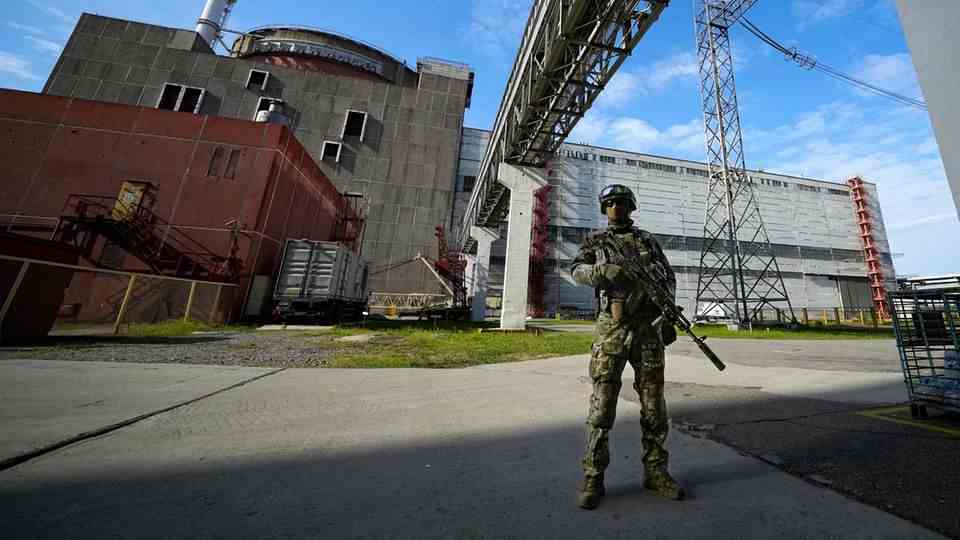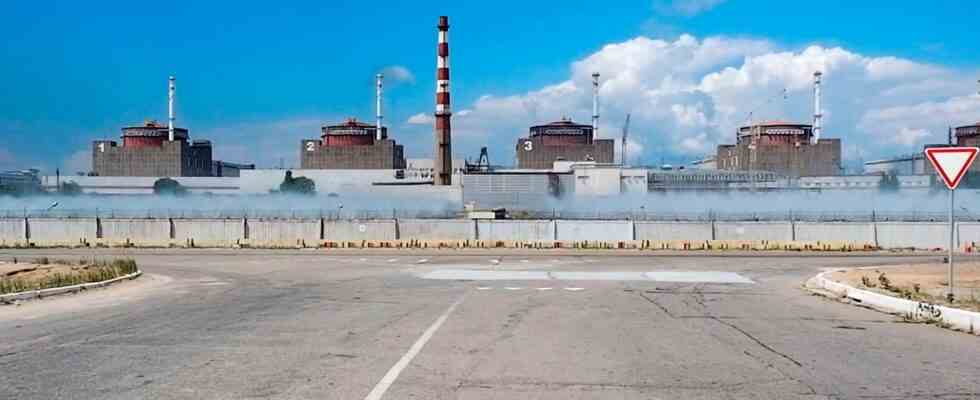Ukraine war
Shot at, line cut, reactors shut down: What is happening at Europe’s largest nuclear power plant?
The Zaporizhia nuclear power plant in a photo by the Russian Ministry of Defense.
© Uncredited/Russian Defense Ministry Press Service/AP / DPA
The Zaporizhia nuclear power plant is in the war zone, it was shelled, the power went out at times and the last line to the energy grid was cut. Russia and Ukraine blame each other. The nuclear regulator IAEA is now giving hope.
The Ukrainian nuclear power plant Zaporizhia has the same name as the regional capital, but is 120 kilometers away in the small town of Enerhodar on the banks of the Dnieper. The situation there is a bit confusing. To put it simply, the river separates the two warring parties here: the Russians have positioned themselves on one side, and the Ukrainians, who are defending their country, on the other. Again and again grenades fly over the Dnieper. According to residents of Nikopol, just across from Enerhodar, the Russians also set up their rocket launchers between apartment buildings and fired north every night.
The first nuclear power plant in the war zone
It is the first time in history that a war has raged around a nuclear power plant. Although Russian soldiers had occupied the nuclear ruins in Chernobyl at the beginning of the Ukraine invasion, there had been no fighting at the time. Different now. Since the beginning of the war, the nuclear power plant has been shot at and hit several times. In March, for example, a grenade hit reactor 1, but its outer shell held up. Most recently, a substation was hit, as well as several transformers. It is unclear who exactly is responsible for the attacks, with Ukraine and Russia blaming each other.

The situation came to a head on Thursday when the power failed on the nuclear power plant site and in the surrounding regions. According to the Ukrainian government, the power plant has now been completely disconnected from the regular Ukrainian power grid due to Russian shelling and is only supplied with electricity via an emergency line. The two reactor blocks that were in operation until the end were shut down in an emergency. In the meantime, the power plant has been connected to the Ukrainian power grid again. The two blocks are still out of service.
Without electricity there is a risk of meltdown
The supply of electricity is essential for the operation of nuclear power plants. This is the only way to keep the cooling circuit running and control the system at all. In normal operation, the power plants supply themselves with electricity, if the supply fails, the emergency power supply usually jumps in. A meltdown occurred in Fukushima after a tsunami destroyed both the reactors and the emergency power supply. Such accident scenarios are considered more likely in security circles than accidents triggered by direct fire.
What children take with them when they have to flee: “The whole life in Ukraine doesn’t fit in a suitcase, but my T-shirt with the smiley face does”
15 images
The Moscow Ministry of Defense said that Europe’s largest nuclear power plant had again been repeatedly shelled by the Ukrainian side with large-caliber artillery. Ukraine promptly denied the accusation: “No one who is at least halfway sane could imagine that Ukraine would attack a nuclear power plant that poses an enormous risk of a nuclear catastrophe and is located on its own territory.”
The Russian occupation administration also reported that both reactors had been shut down in the meantime – but explained that one had already been restarted. The information could not initially be verified independently.
All lines of the power plant cut
According to the Ukrainian operator Enerhoatom, Zaporizhia was cut off from the Ukrainian grid for the first time in its history due to the power outage. The last remaining connection line between the power plant and the Ukrainian power grid was interrupted by fires in ash pits in the adjacent thermal power plant. Three other lines had previously been damaged “by terrorist attacks” by the Russian side.
There are also fears that Russia could feed the electricity produced by the nuclear power plant into its grid. This would be unacceptable, it said from the United States. “To be clear, the nuclear power plant and the electricity it produces belong to Ukraine,” a US State Department official said.
In the case of the Zaporizhia nuclear power plant, the Russians use it as a kind of protective debt. Verified images of the site show that the military has deployed trucks and other military equipment, such as grenade launchers and rocket launchers, there. This agrees with witness statements. In addition, the cooling water basin is said to have been mined. “Every minute that the Russian military stays in the nuclear power plant means the risk of a global radiation catastrophe,” said Ukrainian President Volodymyr Zelenskyy. The military expert Thomas Wiegold said that a nuclear power plant built like this as a military fortress would be practically impregnable. “Because the opponent provokes the danger of radioactive contamination.”
Is nuclear supervision now traveling to Ukraine?
Negotiations have been going on for weeks that representatives of the International Atomic Energy Agency (IAEA) can visit the power plant to find out about the situation. Russia also welcomes the presence of a group of experts, but recently insisted that they enter the country via Russia and not Ukraine, as Kyiv is demanding. Since Friday afternoon, however, a solution seems to be in sight: “Preparations for a visit are being made actively,” said the Russian representative at the international organizations in Vienna, Mikhail Ulyanov. The Ukrainian Energy Minister Herman Halushchenko is also pushing for an early visit by the experts and is also calling for the withdrawal of Russian troops.
Sources: DPA, AFP, “mirror“, “default“, “Bern newspaper“, NTV


